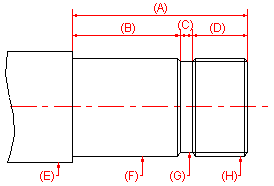|
Technical
information
Reflex
Suppressor fixing details
Unlike a conventional sound moderator which is fixed and
aligned to the barrel only by a small thread and thread
shoulder, reflex suppressors
are aligned at two points on the barrel nearly 8 inches apart.
The front of the suppressor is aligned on a spigot at the
muzzle (see below) and the rear of the suppressor is aligned
on the outside of the barrel by a close-fitting
interchangeable bush. Click here
to see a diagram. When fitted in accordance with the designer's
instructions the retaining thread and shoulder do not
contribute to the correct alignment of the suppressor. This
means that the thread can be made very nearly the full
original diameter of the barrel (-1.0 mm or -0.040" is
usually OK).
Muzzle thread and spigot details
The usual reflex suppressor
muzzle thread and spigot detail is a 15x1 mm (or 17x1 or 14x1) metric thread with a long cylindrical "spigot"
(F) and a relief cut (G) between the thread (H) and the shoulder
(E) - see drawing below. The purpose of the muzzle spigot (F)
is to ensure precise alignment in conjunction with the
close-fitting barrel bush at the rear of the suppressor.

With
this design the muzzle thread (H) is not used for alignment
and the designer advises that the thread
should not be a close fit. Click on Owner's
manual to see a drawing and detailed fitting instructions. From an engineer's point of view, this is
a correct design detail,
like a Paramount or RPA receiver/barrel joint.
We also stock Reflex Suppressors to fit
"legacy" rifle muzzles
which are already threaded 1/2"x20 tpi UNF, 1/2"x28 tpi UNEF
or 5/8"x18
tpi UNF without the locating spigot between thread and
shoulder. In this case, we allow a larger
suppressor exit aperture for some rifle calibres (6.5 mm, for instance
would use 8.5 mm aperture). Other imperial threads including
9/16"x24 tpi and 3/4"x16 tpi UNEF are available to
order or sometimes from stock.
Barrel
bush
The
interchangeable bush at the rear of the Reflex Suppressor is Delrin for
hunting rifles, or brass for military weapons (so it won't
melt with sustained full-auto fire). The bush must be bored on
a lathe to the correct size to fit each individual barrel.
Suppressor
inner tube
The
suppressor expansion chamber has an inner tube which sleeves
back over the barrel (so the combustion gas does not touch the
barrel). The standard inner tube internal diameter is 22 mm.
Click here
to see a diagram.
For barrels larger than
21 mm (0.827") outside diameter (measured at
the back of the suppressor, usually 210 mm from the muzzle) we can
provide a larger diameter inner tube - 25 mm or 29 mm ID. In fact, we can
supply almost any configuration to order, including
specific models for military weapons.
Baffles
Firearm suppressors work by lowering the pressure at
which the powder combustion gas is vented to the atmosphere.
Suppressor baffles provide
a large surface area to cool and condense the combustion gas,
lowering its pressure. The more baffles, the better the sound reduction. Each
doubling of the number of baffles (say from 4 to 8 or from 8
to 16 baffles) reduces the muzzle blast noise by approximately
3 dB (usually 2 to 5 dB).
However,
with supersonic ammunition there is a point of diminishing
returns where the muzzle blast noise is reduced below the
bullet flight noise (which can not be suppressed).
Each extra
group of four baffles extends the reflex
suppressor by about 38 mm
(1.5") and increases the weight by about 80 grams (3 oz).
For pest
control, woodland stalking or target shooting, the T8 model
(eight baffles, 660 gm) is a good
compromise between sound reduction, length and weight. For
highland stalking, where the ratio of miles climbed to shots
fired is rather high, some shooters prefer to save a few
ounces with a T4 (four baffles, 580
gm). Both models comply with HSE Noise at Work Regulations on
a typical 243 or 308 Win stalking rifle.
Baffle
hole diameter
Standard baffle apertures are 7.5 mm , 8,5 mm, 10,5 mm and
13.0 mm. As a rule, the bullet caliber (bullet actual diameter )
plus at least one millimetre gives the exit aperture diameter.
-
7.5 mm hole takes
222, 223, 22-250, 6mm, 243, etc.
-
8.5 mm hole takes
6.5mm 270, 7mm, 308 , 30-06 etc.
-
10.5 mm hole takes 9.3mm,
338 etc.
-
13 mm hole takes
45-70 etc.
-
The reinforced
"magnum" model (stamped "M") for
cartridges above 30-06 case capacity has 10.5 mm exit
aperture as standard (other aperture sizes to special
order).
The
smaller the baffle hole diameter the better the sound
suppression, but the difference between each of the above
hole size increments is only 1 or 2 dB. In general, it is
better to reduce the sound by adding more baffles than
risk making the baffle holes too small.
All rifle bullets yaw a little on leaving the muzzle. The
longer the bullet the more baffle hole clearance we need to accommodate
this yaw without risk of a bullet grazing a baffle. If a
bullet grazes a baffle, it can cause a "flyer" (a
shot which flies well out of the group).
|
![]()
